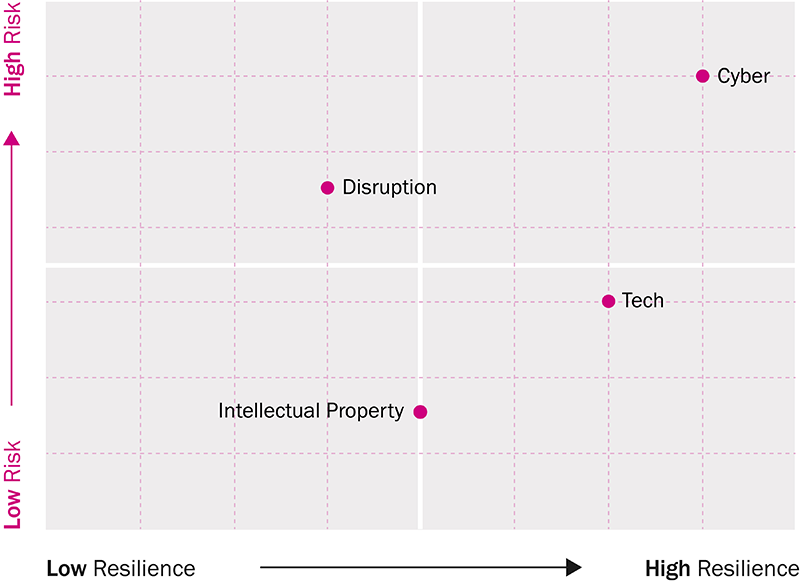Technology risk concerns
According to our research, US leaders are much more concerned about cyber risks than their UK counterparts, who are more concerned about disruption risks. This could be down to longer standing concerns about the reputational and financial impacts of data breaches in the US market. Many of the most high-profile cyberattacks have been on large American companies with many millions of users or customers such as Twitter, Microsoft and Marriott, meaning cybercrime is given loud and regular media coverage. This makes the threat appear much more immediate than elsewhere.
The greater concern among UK business leaders around tech disruption can perhaps be explained by the relative lack of innovation in the UK compared to the US. While the US ranks second in terms of the world’s most innovative countries, the UK fails to make the top ten1. US businesses are more likely to have transformed their businesses through the use of innovative technologies like cloud computing, machine learning and AI and therefore are more exposed to certain cyber risks than businesses in the UK and Europe.
1 These are the 10 most innovative countries in the world | World Economic Forum (weforum.org)Overall, US business leaders feel better prepared to anticipate and respond to the risks within our technology risk category than their UK counterparts.
Percentage of companies ranking each technology risk top, 2021
How resilient are companies to technology risks?
In the US, a median of 55% of businesses feel very prepared to anticipate and respond to cyber risk vs 34% in the UK. The insurance industry has provided solid support in terms of cyber risk management and mitigation, but the rising frequency and value of claims points to the difficulty we all face in managing this risk effectively. The reality is that cyber criminals are well-funded and resourced, efficient and innovative, so can quickly leverage vulnerabilities for maximum gain.
Tech risk, and in particular keeping up with developments, is more a question of business leaders getting the right talent on board and making good and timely investments. Consequently, a median of 44% of UK and US businesses feel very prepared for tech risk challenges.

Intellectual property (IP) and the failure to protect it and other intangible assets is the risk that business leaders worry about least in the technology risk category, with a median of just 12% ranking it their top risk. This is a concern given that intangible assets account for 75% of business value globally and are the predominant source of economic value which needs protecting as we enter the economic headwinds of the post Covid-19 recovery and withdrawal of government support.
By contrast, disruption, and the failure to innovate in line with customer needs or competition is the risk to which business leaders feel least resilient, with a median of well under half (41%) of businesses feeling well prepared to anticipate and respond. As a result of changed working patterns post Covid-19, it is inevitable that businesses are likely to remain at heightened risk of disruption as skilled workers disperse out of city centre jobs and more new tech-enabled business models emerge.
